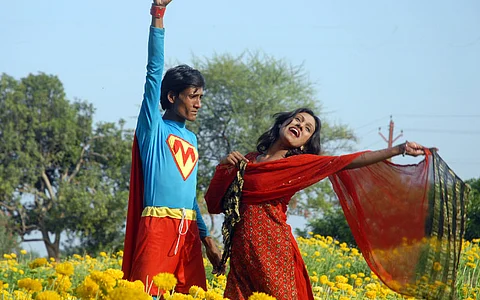
- In-Depth Stories
- Web Stories
- Reviews
- News
- FC Lists
- Interviews
- Features
- FC SpecialsFC Specials

The documentary film Supermen of Malegaon (Faiza Ahmed Khan, 2012) begins with a dedication to Shaikh Shafique's memory, "On the big screen, like he'd dreamed." The dedication itself introduces the crucial theme of aspiration that not only dictates the first sequence but remains rife throughout the film. Through the use of props and sound, the social and economic themes are brought to light. John Gibbs, in his theorisation of mise-en-scène states that these elements are "most productively thought of in terms of their interaction rather than individually … it is the interplay of the elements that is significant." Therefore, this analysis will focus on the use of sound and props in the film but will also draw on their interaction with other coexistent elements like lighting.
The first sequence opens with the sound of looms and the call to prayer being made while the screen is dark. These two sounds already communicate the means of sustenance of the people as well the religious group they belong to. These sounds anticipate and lay the groundwork for the laborious nature of working on power-mills and the communal conflict within the city that is discussed later in the film. The attention of the viewer towards these sounds is captured by rendering the screen dark; when one sense of perception is erased, the others are engaged more deeply.
It proceeds to show an aerial shot of Malegaon silhouetted against dim light and fog, and the sound of the loom picks up. As we get a first glimpse of the loom, we notice the small bulb that illuminates the worker. The camera is closer to this prop so the darkness of the early hours at the looms fills most of the screen. The next shot of the small fluorescent bulb set against a person working on the loom — wearing thick glasses in the dimness — only adds to the bleakness communicated by the shot preceding it. The scene shifts to people who seem to be trapped behind green grills while the looms remain a constant background noise. The camera moves inside the grills, showing the people's hands reaching out. The director uses the grilled area as a prop to set the movie-goers against, instead of explicitly showing the place to be a cinema. The grills express the trapped nature of the workers every day of the week except for Friday, subjected to gruelling monotonous work on the daily, a sentiment echoed by Shafique later in the film.
Shafique names the film-producing community of Malegaon as an aspirational alternative to the obligatory work at the looms that helped ends meet. This later development is also set against the next scene, where the people finally get to enter the cinema, the aspiration that lies behind the obligatory. This scene is followed by the noise of the looms picking up again; the light goes on and off just as various cuts of the looms show up, creating a cacophony of light and sound. This scene makes the viewer feel almost panicked since the editing intensifies the sound as well as the relentless object of the loom, something that can be compared to what Bordwell calls the 'violent impact' of flash frames in his work Editing. He also states that editing can, at a certain moment, fasten our attention on something particular. The emphasis generated creates a mental tattoo of the themes of economic desolation similar to the one created by the sounds at the onset of the film.
In Notes on Sound, Bresson delves into how the power of the cinematographer lies in appealing to both the eyes and ears in a governable way, such that they work in a relay instead of overpowering each other or cancelling the effect of the other out (149). The light and sound sequence is a prime example of this, both elements communicating the constant presence of the material conditions the actors have emerged out of.
Only after this scene does the background sound change, the doors to the grilled room are opened, people rush out in hordes, the scene is marked by the sounds of whistles and excited noises. People climb the grills to get a better view and other people pull them down. Thus, the opening sequence sets the tone of the dual nature of people's lives in Malegaon, between the hours spent labouring away on the looms and the hours spent dreaming of themselves in place of the stars in the cinema.
Further, seeing Malegaon aerially as soon as the film begins seems to be a formal choice supporting the effort on behalf of the filmmaker to show all sides of the city. As the people enter what we get to know is the cinema, we hear the first piece of dialogue being delivered, "Malegaon has many identities." This specific dialogue also helps in setting up what the rest of the film explores: the identity of Malegaon beyond being another city or just another communally divided faction of society. The material realities are established strongly, which only goes to show that exploring the means of sustenance, the status of women along with the exploration of the local filmmaking community isn't mutually exclusive, and that Malegaon has many identities.
Works Cited:
Bordwell, et al. Editing.
Bresson, Robert. Notes on Sound.
Gibbs, John. Mise-En-Scène: Film Style and Interpretation. Wallflower, 2007.
Supermen of Malegaon. Dir. Faiza Ahmed Khan. 2012. YouTube.